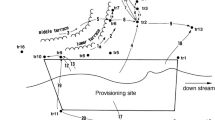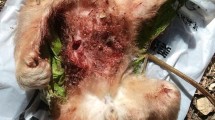Abstract
The troop fissions which occurred in a wild population of Japanese monkeys (Macaca fuscata yakui) were observed from 1977 to 1979 on Yakushima Island. The fissions were initiated in the breeding season by non-troop males who established a consort relation with estrous females. In order to analyze the socio-sexual factors which accelerated the fissions, the male emigrations and immigrations before and after two successive fissions, and the copulation frequencies, competition among males and preferences of mating partners in both sexes in the 1977–78 breeding season after the first fission were examined. The results indicated that three factors (a large number of non-troop males, a shortage of troop males and the females' choice of mating partners) effectively influenced on the establishment of consort relationships between non-troop males and estrous females. It is suggested that these factors may exert different effects on the troop disorganization in relation to troop size. In small-sized troops, a large number of non-troop males and a shortage of troop males may lead to stronger competition between them, and the females' choice affected by prolonged intimate relations with the dominant TMs may reduce their priority of access to estrous females. This situation possibly stimulates fission or male emigration in small-sized troops under the natural conditions on Yakushima Island. In contrast, in large-sized troops under isolated conditions, a surplus rather than a shortage of troop males may contribute to troop disorganization, as most former studies have suggested. A higher socionomic sex ratio may decrease the mating activities of subordinate troop males and increase the competition among them. This situation possibly accelerates the fission of large-sized troops through prolonged interactions between females and subordinate or peripheral troop males. A lower ratio and the females' choice, however, raise the mating chances of subordinate troop males and may not promote the fission of large-sized troops under isolated conditions.
Similar content being viewed by others
References
Altmann, S. A., 1962. Social behaviour of anthropoid primates: Analysis of recent concepts. In:Roots of Behaviour,E. L. Bliss (ed.), Harper, New York, pp. 277–294.
Baxter, M. J. &L. M. Fedigan, 1979. Grooming and consort partner selection in a troop of Japanese monkeys (Macaca fuscata).Arch. Sex. Behav., 8: 445–458.
Carpenter, C. R., 1942. Sexual behaviour of free ranging rhesus monkeys (Macaca mulatta).J. Comp. Psychol., 33: 113–142.
DeVore, I., 1965. Male dominance and mating behaviour in baboons. In:Sex and Behaviour,F. A. Beach (ed.), McGraw-Hill, New York, pp. 266–289.
Enomoto, T., 1974. The sexual behaviour of Japanese monkeys.J. Human Evol., 3: 351–372.
————, 1978. On the social preference in sexual behaviour of Japanese monkeys (Macaca fuscata).J. Human Evol., 7: 283–293.
Fukuda, F., M. Muramatsu &S. Tanaka, 1975. Leaving and joining among troops by males of Yugawara T-troop. In:Life History of Male Japanese Monkeys—Advances in the Field Studies of Japanese Monkeys, Vol. 1,K. Wada,S. Azuma &Y. Sugiyama (eds.), Primate Research Institute, Kyoto Univ., Inuyama, pp. 41–46. (in Japanese)
Furuya, Y., 1960. An example of fission of a natural troop of Japanese monkeys at Gagyusan.Primates, 2: 149–179.
————, 1968. On the fission of troops of Japanese monkeys, I.Primates, 9: 323–350.
————, 1969. On the fission of troops of Japanese monkeys, II. General view of troop fission of Japanese monkeys.Primates, 10: 47–69.
Hanby, J. P., L. T. Robertson &C. H. Phoenix, 1971. The sexual behaviour of a confined troop of Japanese macaques.Folia Primatol., 16: 123–143.
Huffman, M., in prep. Preferential mating and partner selection in female Japanese macaques (Macaca fuscata) at Arashiyama.
Itani, J., 1954. Japanese monkeys at Takasakiyama. In:Nihondobutsuki, Vol. 2,K. Imanishi (ed.), Kobunsha, Tokyo. (in Japanese)
————, 1963. Vocal communication of the wild Japanese monkey.Primates, 4(2): 11–66.
————, 1972. The social structure of Primates. In:Seitaigakukoza, Vol. 19. Kyoritsu-shuppan, Tokyo. (in Japanese)
Izawa, K., 1982.On the Ecology of Japanese Monkeys. Dobutsusha, Tokyo. (in Japanese)
Kano, K., 1964. On the second troop fission of wild Japanese monkeys at Takasakiyama. In:Wild Japanese Monkeys at Takasakiyama,J. Itani, J. Ikeda & T. Tanaka (eds.), Keiso-shobo, pp. 42–73. (in Japanese)
Kawai, M., 1964.On the Ecology of Japanese Monkeys. Kawade-shobo, Tokyo. (in Japanese)
Koyama, N., 1970. Changes in dominance rank and division of a wild Japanese monkey troop in Arashiyama.Primates, 11: 335–390.
Maruhashi, T., 1980. Feeding behaviour and diet of the Japanese monkey (Macaca fuscata yakui) on Yakushima Island, Japan.Primates, 21: 141–160.
————, 1981. Activity patterns of a troop of Japanese monkeys (Macaca fuscata yakui) on Yakushima Island, Japan.Primates, 22: 1–14.
————, 1982. An ecological study of troop fissions of Japanese monkeys (Macaca fuscata yakui) on Yakushima Island, Japan.Primates, 23: 317–337.
————, 1983. An intensive socioecological study of the Yakushimazaru in the western part of Yakushima Island in summer, 1976.The Nihonzaru, 5: 64–74. (in Japanese)
Masui, K., 1976. Records on the troop size and composition of the Japanese monkey (Macaca fuscata)—An examination of the speculations concerning the problems of troop size and population.Physiol. Ecol. Japan, 17: 185–194. (in Japanese)
————,S. Ashizawa, F. Fukuda, S. Uehara &T. Iwano, 1983. Socioecological studies of the Yakushimazaru in the western part of Yakushima Island between 1973 and 1975.The Nihonzaru, 5: 15–63. (in Japanese)
Modahl, K. B. &G. G. Eaton, 1977. Display behaviour in a confined troop of Japanese macaques (Macaca fuscata).Anim. Behav., 25: 525–535.
Nishida, T., 1966. A sociological study of solitary male monkeys,Primates, 7: 141–204.
Nishimura, A., 1973. The third fission of a Japanese monkey group at Takasakiyama. In:Behavioural Regulators of Behaviour in Primates,C. R. Carpenter (ed.), Bucknell Univ. Press, pp. 115–123.
————, 1977. The troop fissions at Takasakiyama—from the third fission to the sixth fission. In:The Research Report of Japanese Monkeys at Takasakiyama (1971–1976), Niimi Press, Ohita City, pp. 37–91. (in Japanese)
Norikoshi, K. &N. Koyama, 1975. Group shifting and social organization among Japanese monkeys. In:Proceed. Symp. 5th Congr. Int. Primatol. Soc.,S. Kondo,M. Kawai,A. Ehara &S. Kawamura (eds.), Japan Science Press, Tokyo, pp. 43–61.
Rostal, D. C. &G. G. Eaton, 1983. Puberty in male Japanese macaques (Macaca fuscata): Social and sexual behaviour in a confined troop.Amer. J. Primatol., 4: 135–141.
Sato, S., 1976. The male bond in matrilineal group. Sociological reexamination of Japanese monkey troop.Hakusan Conservation Research Report., 3: 75–93. (in Japanese)
Sugiyama, Y., 1960. On the division of a natural troop of Japanese monkeys at Takasakiyama.Primates, 2: 109–148.
———— &H. Ohsawa, 1974. Population dynamics of Japanese macaques at Ryozenyama (2). Life history of males. In:Life History of Male Japanese Monkeys—Advances in the Field Studies of Japanese Monkeys, Vol. 1,K. Wada,S. Azuma &Y. Sugiyama (eds.), Primate Research Institute, Kyoto Univ., Inuyama. pp. 55–62. (in Japanese)
Suzuki, A., K. Wada, S. Yoshihiro, E. Tokita, S. Hara &Y. Aburada, 1975. Population dynamics and group movement of Japanese monkeys in Yokoyugawa Valley, Shiga Heights.Physiol. Ecol. Japan, 16: 15–23. (in Japanese)
Takahata, Y., 1980. The reproductive biology of a free-ranging troop of Japanese monkeys.Primates, 21: 303–329.
————, 1982a. Social relations between adult males and females of Japanese monkeys in the Arashiyama B troop.Primates, 23: 1–23.
————, 1982b. The socio-sexual behavior of Japanese monkeys.Z. Tierpsychol., 59: 89–108.
Tokita, E., 1980. The fission of Shiga-A troop of Japanese monkeys.Nat. & Anim., 10: 26–30. (in Japanese)
———— &K. Wada, 1974. The process of male emigration and immigration observed around Shiga-A troop. In:Life History of Male Japanese Monkeys—Advances in the Field Studies of Japanese Monkeys, Vol. 1,K. Wada,S. Azuma &Y. Sugiyama (eds.), Primate Research Institute, Kyoto Univ., Inuyama, pp. 28–34. (in Japanese)
Tokuda, K., 1958. The monkeys of Koshima islet. In:Nihondobutsuki, Vol. 3,K. Imanishi (ed.), Kobunsha, Tokyo. (in Japanese)
Wada, K., 1979.A World of Wild Japanese Monkeys. Kodansha, Tokyo. (in Japanese)
Wolfe, L. D., 1981. Display behaviour of three troops of Japanese monkeys (Macaca fuscata).Primates, 22: 24–32.
Yamagiwa, J., 1979. Some external characters of Japanese monkeys (Macaca fuscata).J. Anthropol. Soc. Nippon, 87: 483–498. (in Japanese)
Author information
Authors and Affiliations
Additional information
This study was financed in part by a Grant-in-Aid for Special Project Research on Biological Aspects of Optimal Strategy and Social Structure from the Japan Ministry of Education, Science and Culture, and by the Cooperative Research Fund of the Primate Research Institute, Kyoto University.
About this article
Cite this article
Yamagiwa, J. Socio-sexual factors of troop fission in wild Japanese monkeys (Macaca fuscata yakui) on Yakushima Island, Japan. Primates 26, 105–120 (1985). https://doi.org/10.1007/BF02382011
Received:
Accepted:
Issue Date:
DOI: https://doi.org/10.1007/BF02382011




